 Yes, another sunflower shot. They are looking east, incidentally, away from the setting sun. And, yes, they look east all day and all night long. When I was a kid someone told me that they actually turned so they always faced the sun. That would be a form of heliotropism, so my high school biology teacher would say.But sunflowers aren't that ambitious.Canon 5DIII 1/80s f/7.1 ISO100 200mm
Yes, another sunflower shot. They are looking east, incidentally, away from the setting sun. And, yes, they look east all day and all night long. When I was a kid someone told me that they actually turned so they always faced the sun. That would be a form of heliotropism, so my high school biology teacher would say.But sunflowers aren't that ambitious.Canon 5DIII 1/80s f/7.1 ISO100 200mm
Blog
08-28-12 The Art of Seeing
 So here's a variation on my themes from yesterday: spider webs and seeing. And here's a quote that every photographer should keep in mind:
So here's a variation on my themes from yesterday: spider webs and seeing. And here's a quote that every photographer should keep in mind:
"Vision is the art of seeing what is invisible to others."Jonathan Swift
Canon 5DIII 1/160s f/4.0 ISO200 100mm
08-27-12 Dewey Web
 When I looked outside yesterday and noticed that our town was enveloped in a thick fog, I figured I would find something unusually photogenic . So when my wife and I went on our morning walk, I did something I don't normally do - I took my camera.Initially, I was disappointed because it was actually too foggy to get much of anything. But then I noticed hundreds of spider webs on fences and plants along the walkway. The webs were coated with beads of water because the air was so humid.I must have taken 30 photos before catching up with Deb, who was walking ahead. But I wasn't satisfied. So I went back a little bit later, this time with my macro lens and tripod. I took another 50 photos and this one is one that I liked.I especially like that each one of the beads of water is a little lens, which reflects the brown and green terrain behind the web and the foggy white sky above. Of course, because it is a lens, everthing is upside down.And, if I hadn't taken my camera, I wouldn't have seen the webs. What's the moral of this story? When I carry my camera, I am a photographer. And when I'm a photographer, I see the world a different way.
When I looked outside yesterday and noticed that our town was enveloped in a thick fog, I figured I would find something unusually photogenic . So when my wife and I went on our morning walk, I did something I don't normally do - I took my camera.Initially, I was disappointed because it was actually too foggy to get much of anything. But then I noticed hundreds of spider webs on fences and plants along the walkway. The webs were coated with beads of water because the air was so humid.I must have taken 30 photos before catching up with Deb, who was walking ahead. But I wasn't satisfied. So I went back a little bit later, this time with my macro lens and tripod. I took another 50 photos and this one is one that I liked.I especially like that each one of the beads of water is a little lens, which reflects the brown and green terrain behind the web and the foggy white sky above. Of course, because it is a lens, everthing is upside down.And, if I hadn't taken my camera, I wouldn't have seen the webs. What's the moral of this story? When I carry my camera, I am a photographer. And when I'm a photographer, I see the world a different way.
08-26-12 Golden (As seen at the Arrow Education Foundation Fund Raiser)
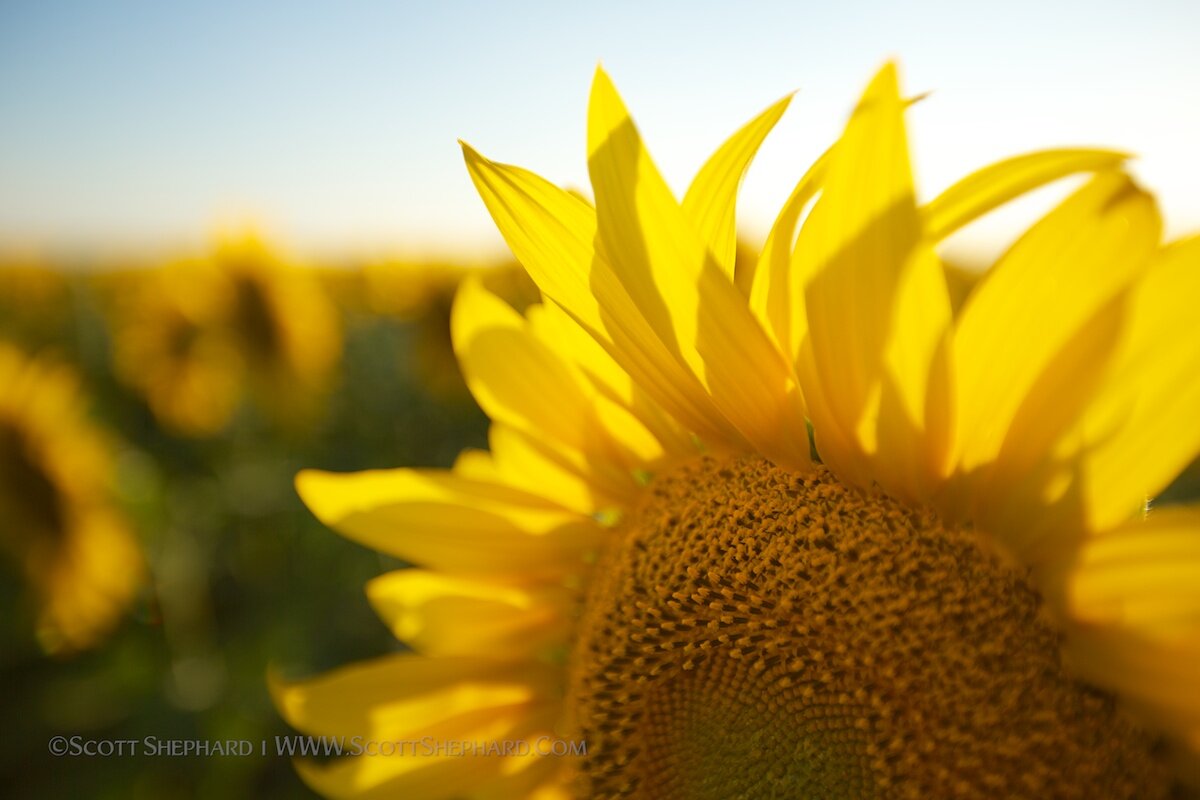 I'm no expert on sunflowers but it seems to me that they go from coming out of the ground to full flower in a fairly short time. And, sadly, they go from full flower to drooping to done in a short time, too.This field is east of Pierre, which doesn't narrow things down much since there are several sunflower fields east of Pierre. We were heading to Lake Oahe, Deb was driving and, after watching several fields go by my window, I said, "Stop. I've got to take some photos."The challenge with photographing sunflowers is something like the challenge of photographing a public building such as the Berlin Hauptbahnhof mentioned yesterday: how do you get a unique picture of something that so many others have photographed? (I just did a Google search for "sunflower pictures" and got 19,000,000 hits!).For better or for worse, this photo is my attempt at something a little different.Canon 5DIII 1/2000s f/2.8 ISO100 35mm[maxbutton id="8"]
I'm no expert on sunflowers but it seems to me that they go from coming out of the ground to full flower in a fairly short time. And, sadly, they go from full flower to drooping to done in a short time, too.This field is east of Pierre, which doesn't narrow things down much since there are several sunflower fields east of Pierre. We were heading to Lake Oahe, Deb was driving and, after watching several fields go by my window, I said, "Stop. I've got to take some photos."The challenge with photographing sunflowers is something like the challenge of photographing a public building such as the Berlin Hauptbahnhof mentioned yesterday: how do you get a unique picture of something that so many others have photographed? (I just did a Google search for "sunflower pictures" and got 19,000,000 hits!).For better or for worse, this photo is my attempt at something a little different.Canon 5DIII 1/2000s f/2.8 ISO100 35mm[maxbutton id="8"]
08-25-12 Yucca
 There isn't much that's real green along Lake Oahe in central South Dakota in late August. But the yucca plant seems to be well adapted to drought conditions and so in some places, that's all that is green.Sometimes, due to erosion along the shores of Oahe, you will see yucca clinging to soil cliffs and if you study them, you will see that they have roots that go down more than 10 feet. That's how they survive.Many South Dakotans have deep roots and that's how we hang on, as well.
There isn't much that's real green along Lake Oahe in central South Dakota in late August. But the yucca plant seems to be well adapted to drought conditions and so in some places, that's all that is green.Sometimes, due to erosion along the shores of Oahe, you will see yucca clinging to soil cliffs and if you study them, you will see that they have roots that go down more than 10 feet. That's how they survive.Many South Dakotans have deep roots and that's how we hang on, as well.
08-24-12 Love's Padlocks
 Quit reading this and click here.Now you know what these padlocks are all about. These padlocks were affixed to a bridge in Ljubljana that was constructed with lovers in mind because it had cables that made it convenient to affix your "love lock."Canon 5DII 1/125s f/6.3 ISO320 58mm
Quit reading this and click here.Now you know what these padlocks are all about. These padlocks were affixed to a bridge in Ljubljana that was constructed with lovers in mind because it had cables that made it convenient to affix your "love lock."Canon 5DII 1/125s f/6.3 ISO320 58mm
08-23-12 Refuge
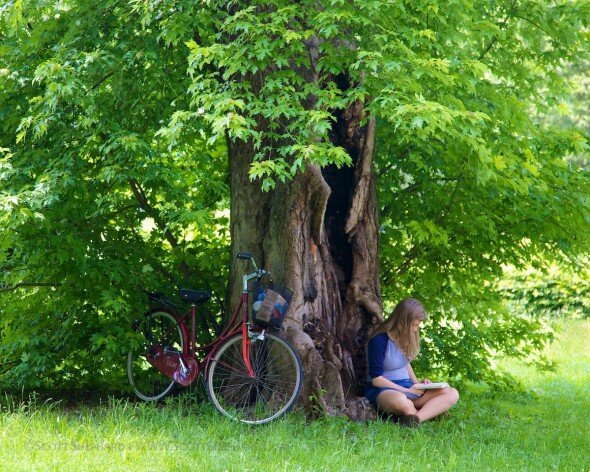 This photo could have been captured anywhere in the western world, I suppose, though its not something you'd see in our small town, mainly because they would feel like they would stand out.This photo was taken in a busy section of Ljubljana, Slovenia, and the woman was so enthralled by her book that she wasn't aware of my camera, which once again turned by into a bit of a voyeur.Canon 5DII 1/125s f/4.5 ISO320 102mm
This photo could have been captured anywhere in the western world, I suppose, though its not something you'd see in our small town, mainly because they would feel like they would stand out.This photo was taken in a busy section of Ljubljana, Slovenia, and the woman was so enthralled by her book that she wasn't aware of my camera, which once again turned by into a bit of a voyeur.Canon 5DII 1/125s f/4.5 ISO320 102mm
08-22-12 Take Me Back To Ljubljana
 It's not that the beer is so good in Ljubljana, Slovenia, that I would love to go back there. I want to go back because it was such a charming place. But the beer helps.Lasko beer, incidentally, is produced by the largest brewery in Slovenia and the symbol on the glass and can is the Zlatorog, or "White Stag." I never saw the white stag in our travels through the Slovenian countryside. But I did see several Laskos.
It's not that the beer is so good in Ljubljana, Slovenia, that I would love to go back there. I want to go back because it was such a charming place. But the beer helps.Lasko beer, incidentally, is produced by the largest brewery in Slovenia and the symbol on the glass and can is the Zlatorog, or "White Stag." I never saw the white stag in our travels through the Slovenian countryside. But I did see several Laskos.
08-21-12 Self-Conscious
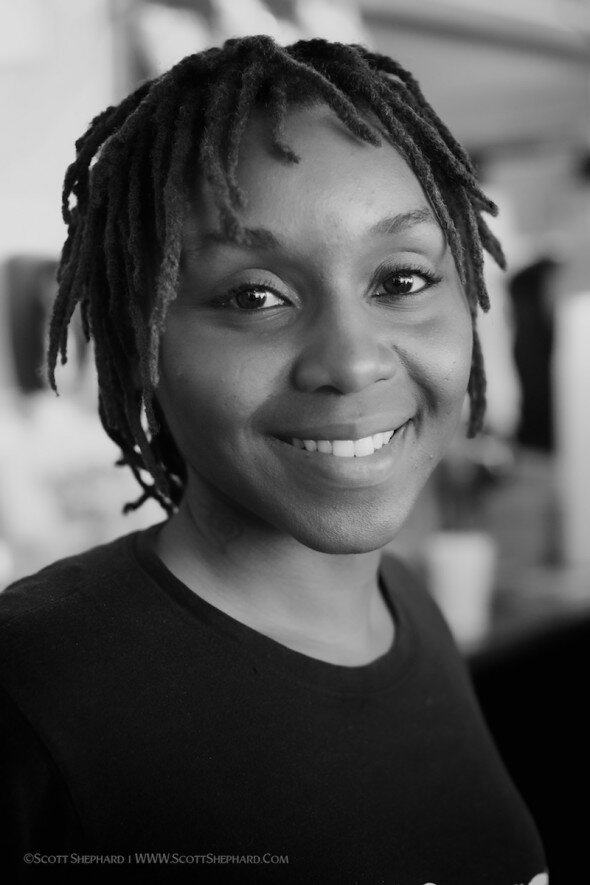 I took this informal portrait of a waitress at the VooDoo BBQ restaurant on St. Charles Avenue in New Orleans. She wasn't the least bit self-conscious, as I think you can see in this photo. I was.And it occurs to me that when I am self-conscious as a photographer, I am not conscious of other, more important considerations than me. For example, if I had been totally "focused" on the task of getting a decent portrait of this young woman, I would have checked the full frame. I would have removed the styrofoam cup behind her. I would have tried to frame the photo so there wasn't a distracting bright area in the upper left corner of the photo. And I would never had tried to take a portrait with a 1/50 sec shutter speed.Why was I self-conscious? Well, I don't normally take semi-posed photos of people I don't know. And I had 5 of my photo/media students sitting at the table watching me.Like so many other subjects and places I've photographed, I'd like to have another chance at the VooDoo BBQ restaurant.Canon 5DII 1/50s f/3.2 ISO1000 50mmPlease take the "A Photo A Day" survey!
I took this informal portrait of a waitress at the VooDoo BBQ restaurant on St. Charles Avenue in New Orleans. She wasn't the least bit self-conscious, as I think you can see in this photo. I was.And it occurs to me that when I am self-conscious as a photographer, I am not conscious of other, more important considerations than me. For example, if I had been totally "focused" on the task of getting a decent portrait of this young woman, I would have checked the full frame. I would have removed the styrofoam cup behind her. I would have tried to frame the photo so there wasn't a distracting bright area in the upper left corner of the photo. And I would never had tried to take a portrait with a 1/50 sec shutter speed.Why was I self-conscious? Well, I don't normally take semi-posed photos of people I don't know. And I had 5 of my photo/media students sitting at the table watching me.Like so many other subjects and places I've photographed, I'd like to have another chance at the VooDoo BBQ restaurant.Canon 5DII 1/50s f/3.2 ISO1000 50mmPlease take the "A Photo A Day" survey!
08-20-12 Glamorous Grain
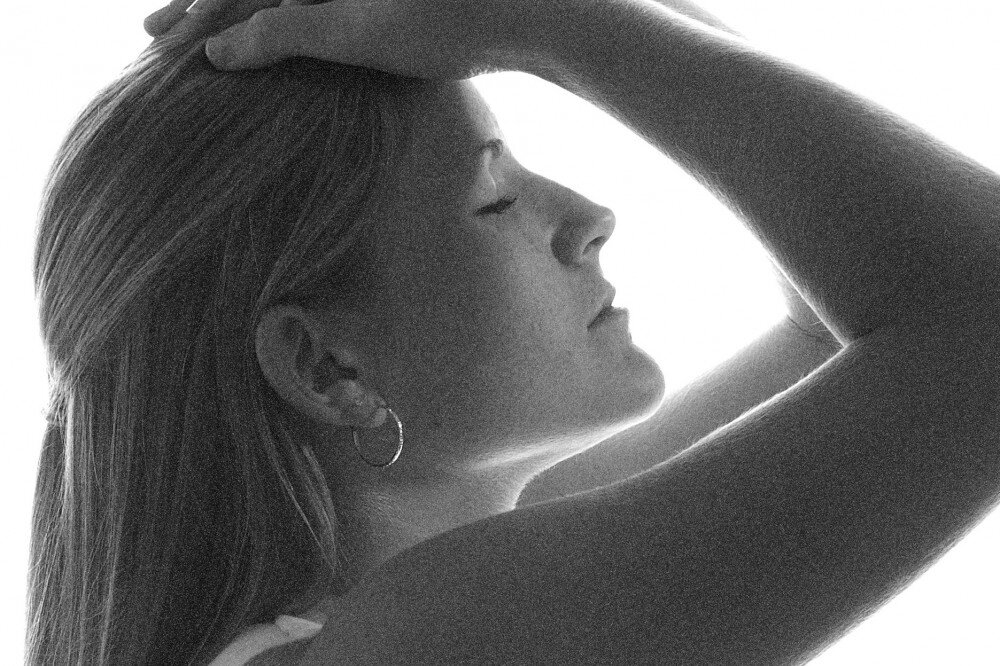 Some of you remember Tri-X Pan black and white film. It was made by Kodak and was a standard "high speed" film with an ISO of 400. That meant that you could shoot in relatively low light with this film. The down side was that you got quite a bit of grain.I can remember that when digital DSLRs hit the market, some photographers bemoaned the fact that digital photos were so smooth - there was no grain. That prompted software companies to make filters that added grain. It was an artistic effect but it also soothed the jangled nerves of photographers who were raised on film.I never missed grain, though I did play with the filters in software from time to time. This photo is evidence of that. It was shot with my 1D II, a camera that led the market at the time and which produced pretty smooth photos at ISO 100, which is what this studio photo was shot with.It occurs to me as I head back into the classroom tomorrow to meet a new group of photography candidates that much of what I've talked about in this post will be foreign to them. But so are phones with cords and movies on cassette tapes. The times, they are a changing, as Dylan says. Or was that Ecclesiastes?Canon 1DII 1/250s f/8.0 ISO100 40mm
Some of you remember Tri-X Pan black and white film. It was made by Kodak and was a standard "high speed" film with an ISO of 400. That meant that you could shoot in relatively low light with this film. The down side was that you got quite a bit of grain.I can remember that when digital DSLRs hit the market, some photographers bemoaned the fact that digital photos were so smooth - there was no grain. That prompted software companies to make filters that added grain. It was an artistic effect but it also soothed the jangled nerves of photographers who were raised on film.I never missed grain, though I did play with the filters in software from time to time. This photo is evidence of that. It was shot with my 1D II, a camera that led the market at the time and which produced pretty smooth photos at ISO 100, which is what this studio photo was shot with.It occurs to me as I head back into the classroom tomorrow to meet a new group of photography candidates that much of what I've talked about in this post will be foreign to them. But so are phones with cords and movies on cassette tapes. The times, they are a changing, as Dylan says. Or was that Ecclesiastes?Canon 1DII 1/250s f/8.0 ISO100 40mm
08-18-12 An Uncommon Place
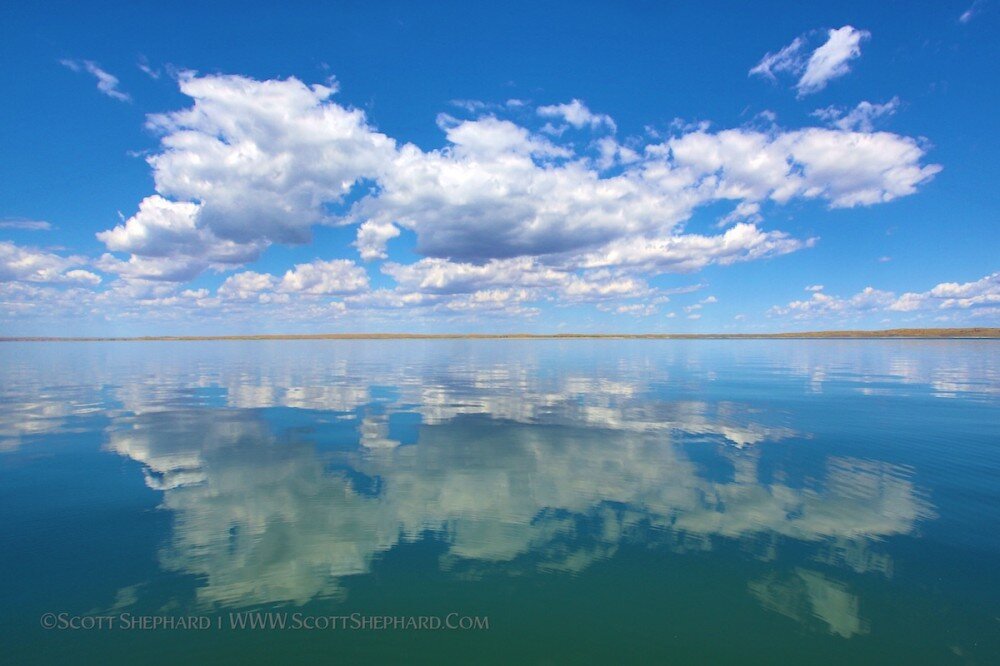 I have been sailing Lake Oahe on the Missouri River in South Dakota for over 20 years. I have seen all kinds of weather and wind. And so you might think I would be jaded, wouldn't you? But I will tell you that I doubt that I will ever got bored by the amazing scenery and experience this place affords.Recently, Deb and I were enjoying our last full day of the season on Lake Oahe. We set sail shortly after sunrise and made it upriver to my favorite place, Mission Creek. By afternoon the wind had slackened and though we enjoy the serentity that this place offers when there is little wind, we decided to go motoring.At one point the wind died completely and I stopped the boat in the middle of the reservoir to enjoy the beautiful clouds, sky and water. The silence was absolute and I was reminded of the simple magic of that keeps drawing me back to Oahe: on this day we weren't looking at a mirror; we were in the mirror.Wandering Star is back in our driveway and will be put into storage soon. I put over 800 miles under her keel this summer, which is equivalent to going east to west across South Dakota and then back again. At about 5 miles an hour. A waste of time? An expensive hobby?"Yes" is a simple answer to those questions. But for me sailing Oahe is an important part of who I am and how I live. For me (and many others I know) it is a truly uncommon place.
I have been sailing Lake Oahe on the Missouri River in South Dakota for over 20 years. I have seen all kinds of weather and wind. And so you might think I would be jaded, wouldn't you? But I will tell you that I doubt that I will ever got bored by the amazing scenery and experience this place affords.Recently, Deb and I were enjoying our last full day of the season on Lake Oahe. We set sail shortly after sunrise and made it upriver to my favorite place, Mission Creek. By afternoon the wind had slackened and though we enjoy the serentity that this place offers when there is little wind, we decided to go motoring.At one point the wind died completely and I stopped the boat in the middle of the reservoir to enjoy the beautiful clouds, sky and water. The silence was absolute and I was reminded of the simple magic of that keeps drawing me back to Oahe: on this day we weren't looking at a mirror; we were in the mirror.Wandering Star is back in our driveway and will be put into storage soon. I put over 800 miles under her keel this summer, which is equivalent to going east to west across South Dakota and then back again. At about 5 miles an hour. A waste of time? An expensive hobby?"Yes" is a simple answer to those questions. But for me sailing Oahe is an important part of who I am and how I live. For me (and many others I know) it is a truly uncommon place.
08-17-12 What Do You See?
 I don't know about you, but I have never looked closely at a human eye before I edited this photo. The eye you're looking at belongs to Tiffany, one of my Photo/Media students at Lake Area Technical Institute, and she was a good sport when I spontaneously told her I wanted to photograph her eyes. We went up to an area in our school that has great northern light and I took several photos.I'm not sure if a viewer would find this photo fascinating or a bit unsettling. If it's unsettling, I can tell you that it shouldn't be because Tiffany wouldn't unsettle you: she is a beautiful person, with a beautiful personality. And she has beautiful eyes.Sorry for the deep thoughts here but I think close-ups of body parts, like a single human eye, are striking because we don't tend to look so closely at them. In fact, if someone stares at us too long, we often look away. Further, an eye is in the realm of people like optometrists, not teachers, friends and acquaintances. And beyond that, it is only part of a whole that we call our bodies. I believe we are less our bodies than we are our experiences. Our bodies are like suitcases (Samsonite? Luis Vuitton?) in to which we pack our true selves.That aside, today I am showing you Tiffany's eye and asking you "What do you see?" In my case, to quote the famous discoverer Howard Carter, I see "wonderful things". . . .Canon 5DII 1/60s f/4.0 ISO200 100mm
I don't know about you, but I have never looked closely at a human eye before I edited this photo. The eye you're looking at belongs to Tiffany, one of my Photo/Media students at Lake Area Technical Institute, and she was a good sport when I spontaneously told her I wanted to photograph her eyes. We went up to an area in our school that has great northern light and I took several photos.I'm not sure if a viewer would find this photo fascinating or a bit unsettling. If it's unsettling, I can tell you that it shouldn't be because Tiffany wouldn't unsettle you: she is a beautiful person, with a beautiful personality. And she has beautiful eyes.Sorry for the deep thoughts here but I think close-ups of body parts, like a single human eye, are striking because we don't tend to look so closely at them. In fact, if someone stares at us too long, we often look away. Further, an eye is in the realm of people like optometrists, not teachers, friends and acquaintances. And beyond that, it is only part of a whole that we call our bodies. I believe we are less our bodies than we are our experiences. Our bodies are like suitcases (Samsonite? Luis Vuitton?) in to which we pack our true selves.That aside, today I am showing you Tiffany's eye and asking you "What do you see?" In my case, to quote the famous discoverer Howard Carter, I see "wonderful things". . . .Canon 5DII 1/60s f/4.0 ISO200 100mm
